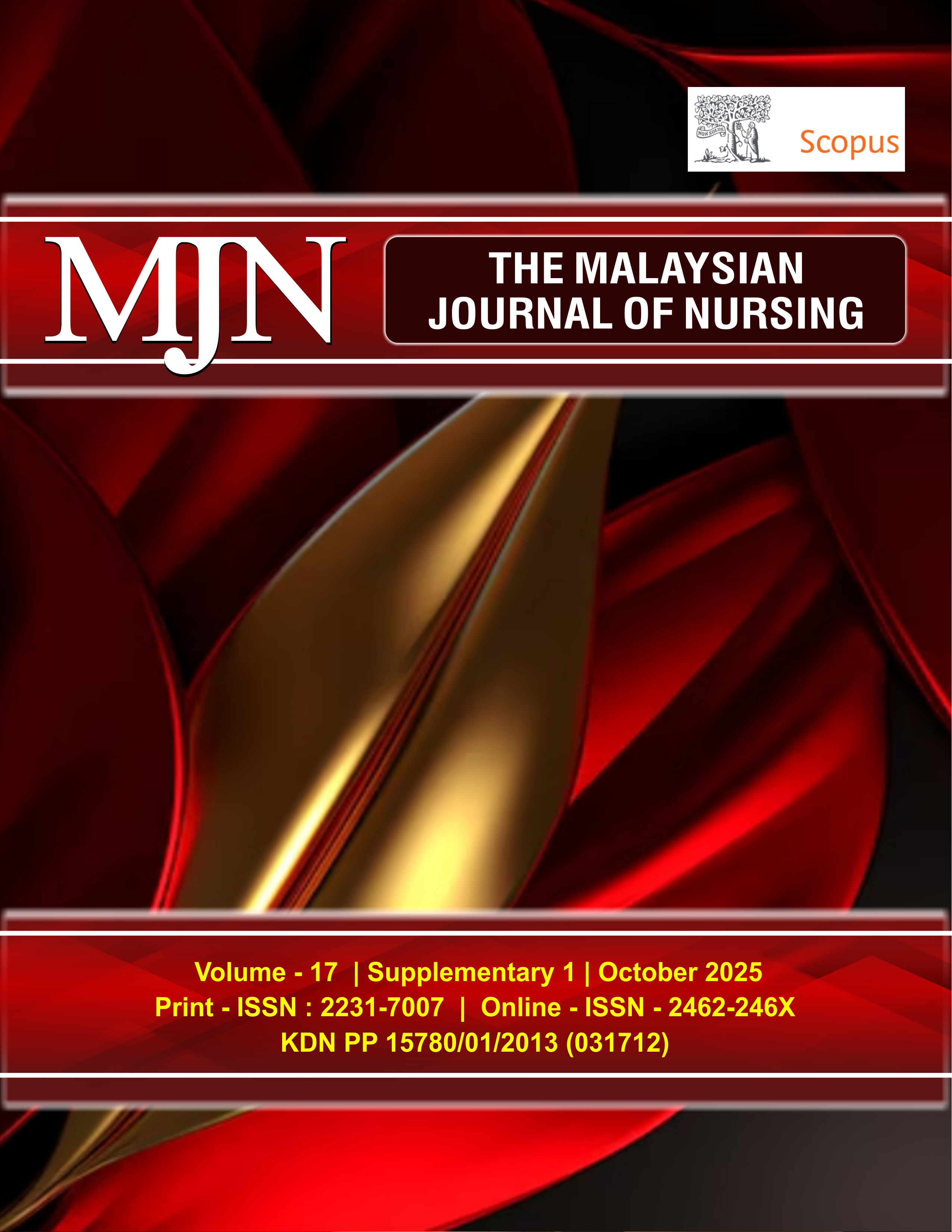Determine the Prevalence and Causative Factors for Needle Stick Injuries between Nursing Staff at Karbala City
DOI:
https://doi.org/10.31674/mjn.2025.v17isupp1.014Abstract
Background: Needle-stick injuries (NSIs) constitute a serious hazard to healthcare workers in any healthcare setting. The present study aimed to determine the prevalence and causative factors for needle-stick injuries among nursing staff in Karbala City. Methods: A descriptive cross-sectional design was conducted; 200 nurses working at Safeer and Zain Alabdeen hospitals in Karbala province joined the research for their NSIs experience. Each respondent completed a questionnaire that was divided into three parts with closed questions. Results: Most of the sample were female, aged between 20 and 25 years with diplomas or bachelor’s degrees, had less than 5 years of experience in nursing, had attended training courses and were vaccinated against the Hepatitis C virus. The prevalence of needle-stick injuries was 69%. Related to the causative factors of needlestick injuries, the most important causes from nurses' perspective were overcrowding, fatigue, and recapping the contaminated needle by hand. There were statistically significant differences between needle-stick injury and the nurses’ years of experience, as well as attendance at training courses on how to avoid needle-stick injury accidents. Conclusion: The needle-stick injury prevalence rate was found to be 69%. By promoting a safe and conducive work environment, the findings aim to assist national educational institutions, public health organizations, and hospital administrations in Iraq in making informed decisions regarding the prevention and control of needle-stick injuries in the future.
Keywords:
Needle-Stick Injuries, Nurses, Questionnaire-Based SurveyDownloads
References
Abalkhail, A., Kabir, R., Elmosaad, Y. M., Alwashmi, A. S., Alhumaydhi, F. A., Alslamah, T., ... & Mahmud, I. (2022). Needle-stick and sharp injuries among hospital healthcare workers in Saudi Arabia: a cross-sectional survey. International Journal of Environmental Research and Public Health, 19(10). https://doi.org/10.3390/ijerph19106342
Almoliky, M.A., Elzilal, H. A., Alzahrani, E., Abo-Dief, H. M., Saleh, K. A., Alkubati, S. A., ... & Sultan, M. A. (2024). Prevalence and associated factors of needle stick and sharp injuries among nurses: a cross-sectional study. SAGE Open Medicine, 12. https://doi.org/10.1177/20503121231221445
Abebe, A. M., Kassaw, M. W., & Shewangashaw, N. E. (2018). Prevalence of needle-stick and sharp object injuries and its associated factors among staff nurses in Dessie referral hospital Amhara region, Ethiopia, 2018. BMC Research Notes, 11, 1-6. https://doi.org/10.1186/s13104-018-3930-4
Adams, D. (2012). Needlestick and sharps injuries: practice update. Nursing Standard, 26(37). https://doi.org/10.7748/ns2012.05.26.37.49.c9107
Afridi, A. A. K., Kumar, A., & Sayani, R. (2013). Needle stick injuries–risk and preventive factors: a study among health care workers in tertiary care hospitals in Pakistan. Global Journal of Health Science, 5(4), 85. https://doi.org/10.5539/gjhs.v5n4p85
Akbari, J., Taheri, M., Khosravi, N., Zamani, S., & Ghadami, A. (2018). Work related stress and needlestick injuries (NIs): A study among Iranian nurses with/without NIs. Ergonomics International Journal, 23, 1-11. https://doi.org/10.23880/eoij-16000184
Alaru, M., Kyiu, C., Yariga, F., & Osman, A. (2023). Prevalence of needle stick injury among healthcare workers in Savelugu Municipal Hospital. Asian Journal of Medicine and Health, 21, 127-36. https://doi.org/10.9734/ajmah/2023/v21i12968
National Institute for Occupational Safety and Health (1999). Preventing needlestick injuries in health care settings (DHHS [NIOSH] Publication No. 2000-108). U.S. Department of Health and Human Services, Centers for Disease Control and Prevention. https://www.cdc.gov/niosh/docs/2000-108
Alharazi, R., Almutary, H., Felemban, O., Alariany, A. S., Alshamrani, F. A., Hawsawi, E. H., & Alsulami, L. M. (2022). Prevalence of needle stick injuries among nurses in Jeddah, Saudi Arabia. Nursing: Research and Reviews, 235-246. https://doi.org/10.2147/NRR.S376343
Anwar, M. M., Mohamed Lotfy, A. A., & Alrashidy, A. A. (2019). Safe injection awareness and practices among nursing staff in an Egyptian and a Saudi hospital. Journal of the Egyptian Public Health Association, 94, 1-8. https://doi.org/10.1186/s42506-019-0018-5
Anwar, M., Shah, B. A., Hussain, S., Ullah, A., Amin, I., & Ali, N. (2025). Assessment of knowledge, attitudes and practice regarding needles sticks injuries among nurses in district Peshawar. The Research of Medical Science Review, 3(1), 227-232. Retrieved from: http://thermsr.com/index.php/Journal/article/view/360 . Accessed on 18th May 2024.
Arora, A., Biswas, S., Pahwa, V., Bansal, N., Verghese, S., Rodrigues, N., ... & Saxena, A. (2024). Study of behavioural and psychosocial factors relating to needle stick injuries in nursing staff of a tertiary care cancer hospital of Punjab, India. Iranian Journal of Microbiology, 16(2), 201- 207. https://doi.org/10.18502/ijm.v16i2.15353
Bassiouny, D. M., Said, A. M., Elkashef, S., El Anwar, A. H., El Shanawany, P., & Essam, S. (2025). Needle stick injuries among healthcare workers of Cairo university tertiary care hospitals between incidence, knowledge and response. Egyptian Journal of Medical Microbiology, 34(1). https://doi.org/10.21608/ejmm.2024.331304.1363
Centers for Disease Control and prevention. (2024, May 17). National Institute for Occupational Safety and Health. Retrieved from: https://www.cdc.gov/niosh/index.html. Accessed on 29th April, 2024.
Gao, H., Liu, M., Su, Y., Li, Y., & Tian, L. (2024). Analysis of factors associated with needlestick injuries of clinical nurses by applying a human factor analysis and classification system: A nationwide cross‐sectional survey. Journal of Clinical Nursing, 33(6), 2178-2189. https://doi.org/10.1111/jocn.16959
Guimarães, H. M., Corrêa, A. P. V., & Uehara, S. C. S. A. (2022). Perfil e fatores associados aos acidentes com perfurocortantes entre a equipe de enfermagem [Profile and factors associated with sharps accidents among nursing staff]. Revista Enfermagem UERJ, 30. https://doi.org/10.12957/reuerj.2022.68717
Higazee, M. Z. A., Rayan, A., & Khalil, M. (2016). Relationship between job stressors and organizational support among Jordanian nurses. American Journal of Nursing Research, 4(3), 51-55. Retrieved from: https://pubs.sciepub.com/ajnr/4/3/1/index.html, Accessed on 28th May, 2024.
Kebede, A., & Gerensea, H. (2018). Prevalence of needle stick injury and its associated factors among nurses working in public hospitals of Dessie town, Northeast Ethiopia, 2016. BMC Research Notes, 11, 1-6. https://doi.org/10.1186/s13104-018-3529-9
Kiddeer, M., Basit, A., Ahmad, T., & Masood, I. (2024). Needle stick injuries and post-exposure prophylaxis practices among healthcare personnel working at tertiary care hospitals in Punjab, Pakistan. International Journal of Risk & Safety in Medicine, 35(4), 308-316. https://doi.org/10.1177/09246479241302295
Li, X., He, Q., & Zhao, H. (2024). Situation and associated factors of needle stick and sharps injuries among health-care workers in a tertiary hospital: a cross-sectional survey. BMC Health Services Research, 24(1). https://doi.org/10.1186/s12913-024-11439-5
Mekonnen, R., Yosef, H., Teklegiorgis, K., Tesfaye, F., & Dagne, I. (2018). Magnitude and impact of occupational related needle stick and sharp injuries and associated factors among health care workers in Dire Dawa, Eastern Ethiopia. Medical Safety & Global Health, 7(1), 2574-0407. https://doi.org/10.4172/2574-0407.1000141
Musana, . P., Nansereko, . H., Tubenawe, . M., Nalubega, J. F. ., & Naggulu, I. P. (2025). Knowledge And Practices of Prevention and Control of Needle Stick Injuries Among Nurses and Medical Officers at Wakiso Health Center IV, A Cross-Sectional Study. Student’s Journal of Health Research Africa, 6(3), 8. https://doi.org/10.51168/sjhrafrica.v6i3.1534
Reddy, V. K., Lavoie, M. C., Verbeek, J. H., & Pahwa, M. (2017). Devices for preventing percutaneous exposure injuries caused by needles in healthcare personnel. Cochrane Database of Systematic Reviews, (11). https://doi.org/10.1002/14651858.CD009740.pub3
Singh, S., Singh, B., Singh, S., Khurana, A., & Verma, R. (2019). Study of knowledge, attitude and practice among nurses regarding needle stick and sharp item injuries. International Journal of Community Medicine and Public Health, 6(5), 2064–2068. https://doi.org/10.18203/2394-6040.ijcmph20191819
Zarei, O., Zeraatpishe, F., Beygi, N., Moghadam, M. T., Mousavi Shahraki, S. F., Naghizadeh, M. M., & Bijani, M. (2025). Investigating the relationship between clinical competence and the incidence of needle-stick injuries (NSIs) and their contributing factors in nurses: a descriptive cross-sectional study in Southern Iran. BMC Nursing, 24(1). https://doi.org/10.1186/s12912-025-02839-x
Published
How to Cite
Issue
Section
License
Copyright (c) 2025 The Malaysian Journal of Nursing (MJN)

This work is licensed under a Creative Commons Attribution-NonCommercial-NoDerivatives 4.0 International License.



































